Sustainable Tourism Development
VerifiedAdded on 2020/01/28
|17
|5211
|51
Essay
AI Summary
This assignment requires a critical analysis of sustainable tourism development practices. Students are tasked with exploring various case studies of sustainable tourism initiatives and examining their effects on economic growth, social well-being, and environmental protection. The analysis should delve into the challenges and opportunities associated with implementing sustainable tourism strategies in different destinations.
Contribute Materials
Your contribution can guide someone’s learning journey. Share your
documents today.

Sustainable Tourism
Development
Development
Secure Best Marks with AI Grader
Need help grading? Try our AI Grader for instant feedback on your assignments.
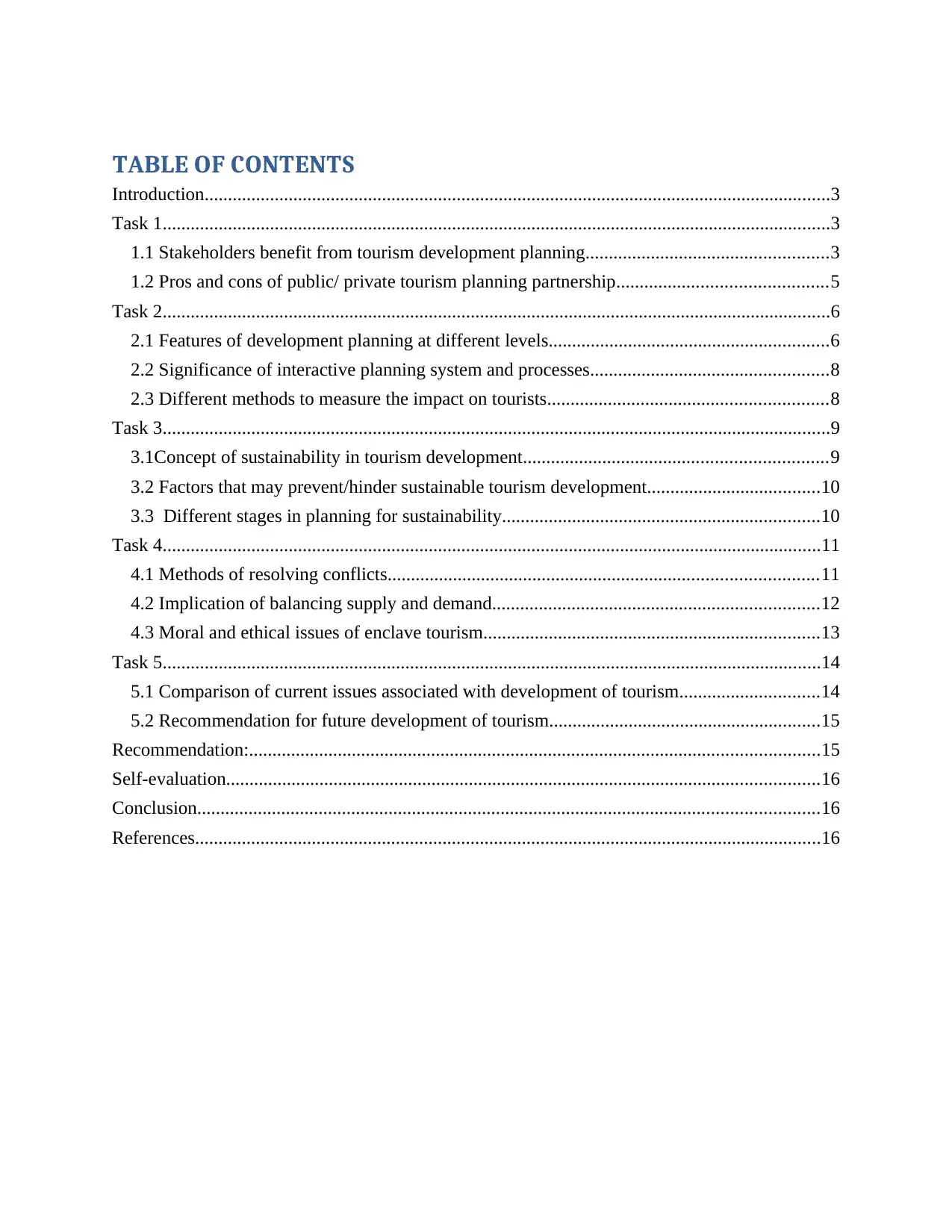
TABLE OF CONTENTS
Introduction......................................................................................................................................3
Task 1...............................................................................................................................................3
1.1 Stakeholders benefit from tourism development planning....................................................3
1.2 Pros and cons of public/ private tourism planning partnership.............................................5
Task 2...............................................................................................................................................6
2.1 Features of development planning at different levels............................................................6
2.2 Significance of interactive planning system and processes...................................................8
2.3 Different methods to measure the impact on tourists............................................................8
Task 3...............................................................................................................................................9
3.1Concept of sustainability in tourism development.................................................................9
3.2 Factors that may prevent/hinder sustainable tourism development.....................................10
3.3 Different stages in planning for sustainability....................................................................10
Task 4.............................................................................................................................................11
4.1 Methods of resolving conflicts............................................................................................11
4.2 Implication of balancing supply and demand......................................................................12
4.3 Moral and ethical issues of enclave tourism........................................................................13
Task 5.............................................................................................................................................14
5.1 Comparison of current issues associated with development of tourism..............................14
5.2 Recommendation for future development of tourism..........................................................15
Recommendation:..........................................................................................................................15
Self-evaluation...............................................................................................................................16
Conclusion.....................................................................................................................................16
References......................................................................................................................................16
Introduction......................................................................................................................................3
Task 1...............................................................................................................................................3
1.1 Stakeholders benefit from tourism development planning....................................................3
1.2 Pros and cons of public/ private tourism planning partnership.............................................5
Task 2...............................................................................................................................................6
2.1 Features of development planning at different levels............................................................6
2.2 Significance of interactive planning system and processes...................................................8
2.3 Different methods to measure the impact on tourists............................................................8
Task 3...............................................................................................................................................9
3.1Concept of sustainability in tourism development.................................................................9
3.2 Factors that may prevent/hinder sustainable tourism development.....................................10
3.3 Different stages in planning for sustainability....................................................................10
Task 4.............................................................................................................................................11
4.1 Methods of resolving conflicts............................................................................................11
4.2 Implication of balancing supply and demand......................................................................12
4.3 Moral and ethical issues of enclave tourism........................................................................13
Task 5.............................................................................................................................................14
5.1 Comparison of current issues associated with development of tourism..............................14
5.2 Recommendation for future development of tourism..........................................................15
Recommendation:..........................................................................................................................15
Self-evaluation...............................................................................................................................16
Conclusion.....................................................................................................................................16
References......................................................................................................................................16
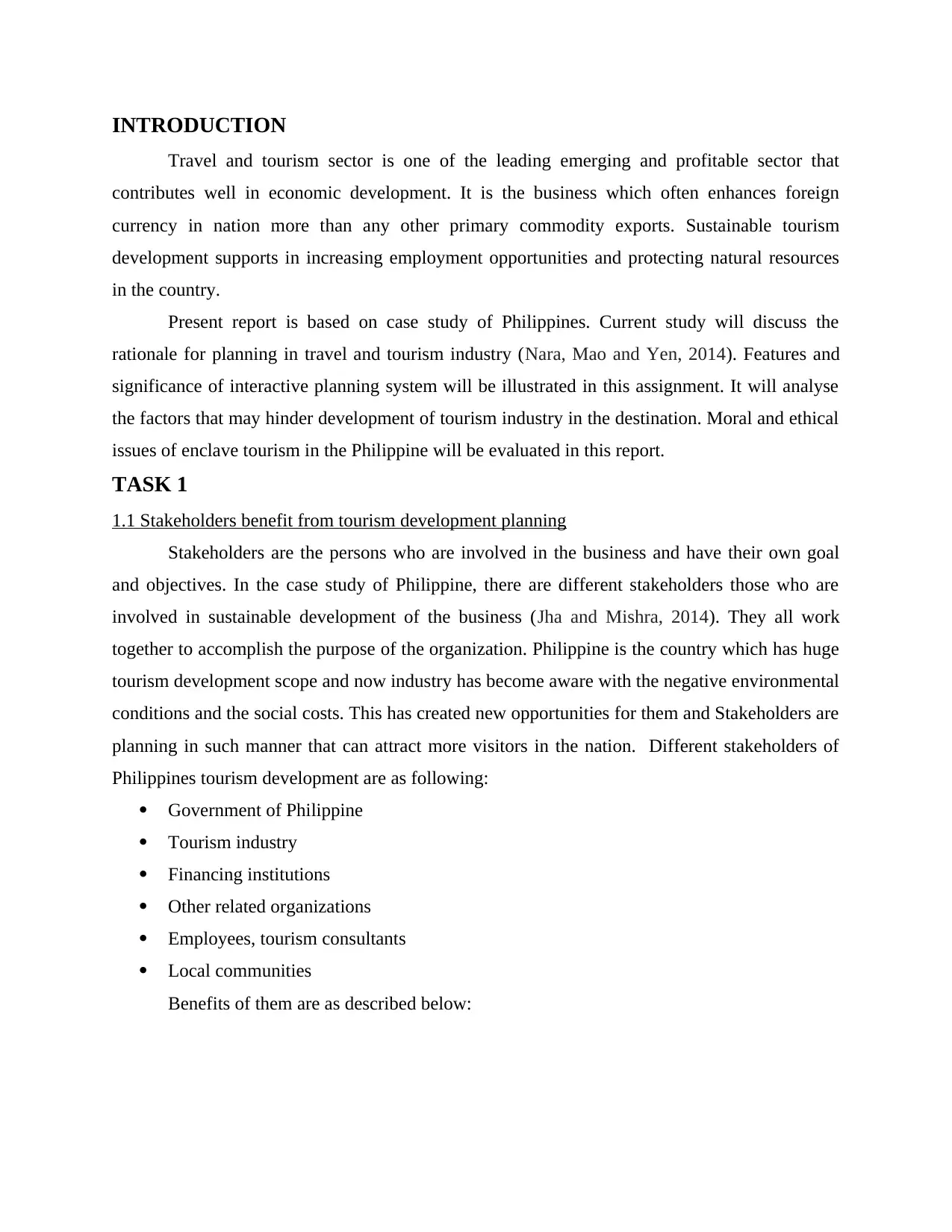
INTRODUCTION
Travel and tourism sector is one of the leading emerging and profitable sector that
contributes well in economic development. It is the business which often enhances foreign
currency in nation more than any other primary commodity exports. Sustainable tourism
development supports in increasing employment opportunities and protecting natural resources
in the country.
Present report is based on case study of Philippines. Current study will discuss the
rationale for planning in travel and tourism industry (Nara, Mao and Yen, 2014). Features and
significance of interactive planning system will be illustrated in this assignment. It will analyse
the factors that may hinder development of tourism industry in the destination. Moral and ethical
issues of enclave tourism in the Philippine will be evaluated in this report.
TASK 1
1.1 Stakeholders benefit from tourism development planning
Stakeholders are the persons who are involved in the business and have their own goal
and objectives. In the case study of Philippine, there are different stakeholders those who are
involved in sustainable development of the business (Jha and Mishra, 2014). They all work
together to accomplish the purpose of the organization. Philippine is the country which has huge
tourism development scope and now industry has become aware with the negative environmental
conditions and the social costs. This has created new opportunities for them and Stakeholders are
planning in such manner that can attract more visitors in the nation. Different stakeholders of
Philippines tourism development are as following:
Government of Philippine
Tourism industry
Financing institutions
Other related organizations
Employees, tourism consultants
Local communities
Benefits of them are as described below:
Travel and tourism sector is one of the leading emerging and profitable sector that
contributes well in economic development. It is the business which often enhances foreign
currency in nation more than any other primary commodity exports. Sustainable tourism
development supports in increasing employment opportunities and protecting natural resources
in the country.
Present report is based on case study of Philippines. Current study will discuss the
rationale for planning in travel and tourism industry (Nara, Mao and Yen, 2014). Features and
significance of interactive planning system will be illustrated in this assignment. It will analyse
the factors that may hinder development of tourism industry in the destination. Moral and ethical
issues of enclave tourism in the Philippine will be evaluated in this report.
TASK 1
1.1 Stakeholders benefit from tourism development planning
Stakeholders are the persons who are involved in the business and have their own goal
and objectives. In the case study of Philippine, there are different stakeholders those who are
involved in sustainable development of the business (Jha and Mishra, 2014). They all work
together to accomplish the purpose of the organization. Philippine is the country which has huge
tourism development scope and now industry has become aware with the negative environmental
conditions and the social costs. This has created new opportunities for them and Stakeholders are
planning in such manner that can attract more visitors in the nation. Different stakeholders of
Philippines tourism development are as following:
Government of Philippine
Tourism industry
Financing institutions
Other related organizations
Employees, tourism consultants
Local communities
Benefits of them are as described below:
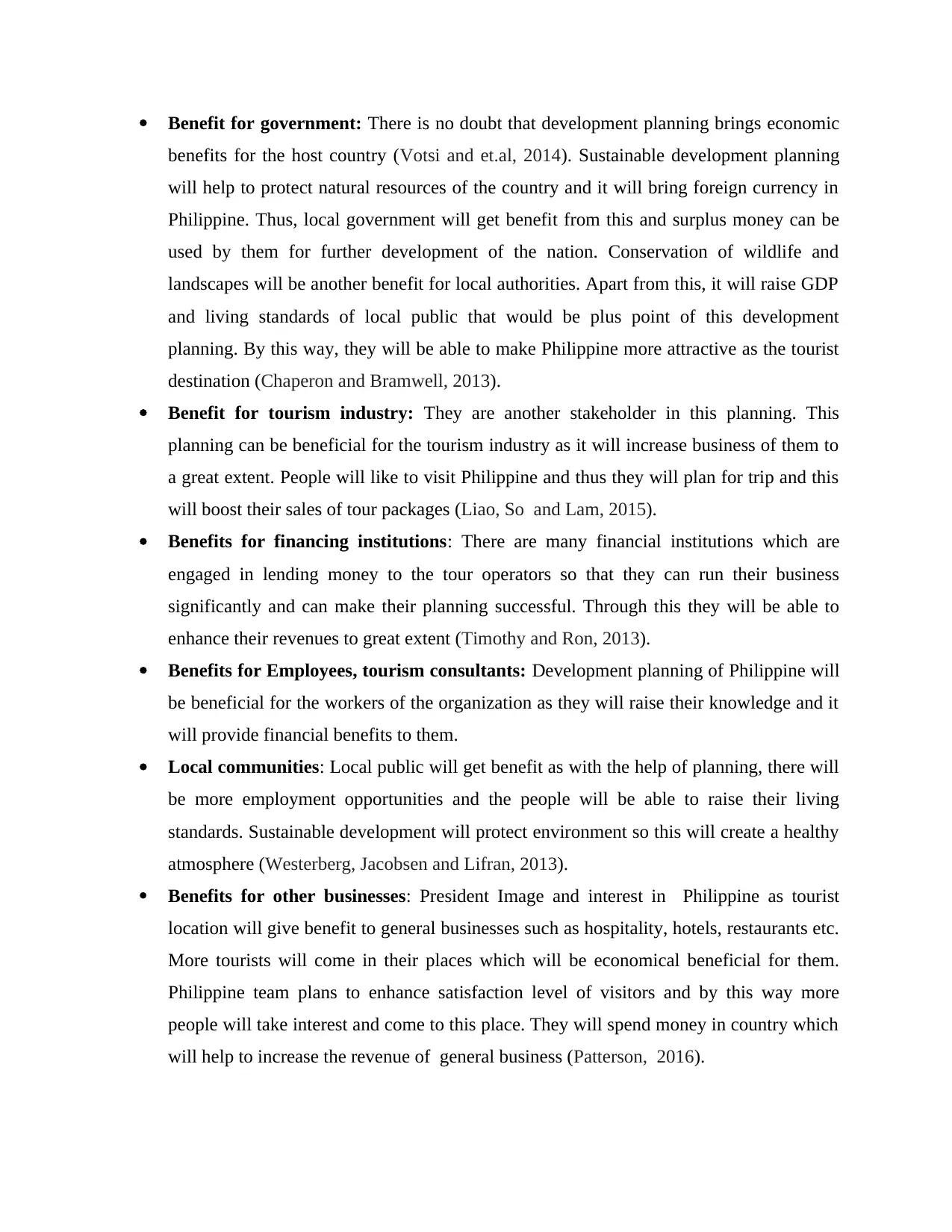
Benefit for government: There is no doubt that development planning brings economic
benefits for the host country (Votsi and et.al, 2014). Sustainable development planning
will help to protect natural resources of the country and it will bring foreign currency in
Philippine. Thus, local government will get benefit from this and surplus money can be
used by them for further development of the nation. Conservation of wildlife and
landscapes will be another benefit for local authorities. Apart from this, it will raise GDP
and living standards of local public that would be plus point of this development
planning. By this way, they will be able to make Philippine more attractive as the tourist
destination (Chaperon and Bramwell, 2013).
Benefit for tourism industry: They are another stakeholder in this planning. This
planning can be beneficial for the tourism industry as it will increase business of them to
a great extent. People will like to visit Philippine and thus they will plan for trip and this
will boost their sales of tour packages (Liao, So and Lam, 2015).
Benefits for financing institutions: There are many financial institutions which are
engaged in lending money to the tour operators so that they can run their business
significantly and can make their planning successful. Through this they will be able to
enhance their revenues to great extent (Timothy and Ron, 2013).
Benefits for Employees, tourism consultants: Development planning of Philippine will
be beneficial for the workers of the organization as they will raise their knowledge and it
will provide financial benefits to them.
Local communities: Local public will get benefit as with the help of planning, there will
be more employment opportunities and the people will be able to raise their living
standards. Sustainable development will protect environment so this will create a healthy
atmosphere (Westerberg, Jacobsen and Lifran, 2013).
Benefits for other businesses: President Image and interest in Philippine as tourist
location will give benefit to general businesses such as hospitality, hotels, restaurants etc.
More tourists will come in their places which will be economical beneficial for them.
Philippine team plans to enhance satisfaction level of visitors and by this way more
people will take interest and come to this place. They will spend money in country which
will help to increase the revenue of general business (Patterson, 2016).
benefits for the host country (Votsi and et.al, 2014). Sustainable development planning
will help to protect natural resources of the country and it will bring foreign currency in
Philippine. Thus, local government will get benefit from this and surplus money can be
used by them for further development of the nation. Conservation of wildlife and
landscapes will be another benefit for local authorities. Apart from this, it will raise GDP
and living standards of local public that would be plus point of this development
planning. By this way, they will be able to make Philippine more attractive as the tourist
destination (Chaperon and Bramwell, 2013).
Benefit for tourism industry: They are another stakeholder in this planning. This
planning can be beneficial for the tourism industry as it will increase business of them to
a great extent. People will like to visit Philippine and thus they will plan for trip and this
will boost their sales of tour packages (Liao, So and Lam, 2015).
Benefits for financing institutions: There are many financial institutions which are
engaged in lending money to the tour operators so that they can run their business
significantly and can make their planning successful. Through this they will be able to
enhance their revenues to great extent (Timothy and Ron, 2013).
Benefits for Employees, tourism consultants: Development planning of Philippine will
be beneficial for the workers of the organization as they will raise their knowledge and it
will provide financial benefits to them.
Local communities: Local public will get benefit as with the help of planning, there will
be more employment opportunities and the people will be able to raise their living
standards. Sustainable development will protect environment so this will create a healthy
atmosphere (Westerberg, Jacobsen and Lifran, 2013).
Benefits for other businesses: President Image and interest in Philippine as tourist
location will give benefit to general businesses such as hospitality, hotels, restaurants etc.
More tourists will come in their places which will be economical beneficial for them.
Philippine team plans to enhance satisfaction level of visitors and by this way more
people will take interest and come to this place. They will spend money in country which
will help to increase the revenue of general business (Patterson, 2016).
Paraphrase This Document
Need a fresh take? Get an instant paraphrase of this document with our AI Paraphraser
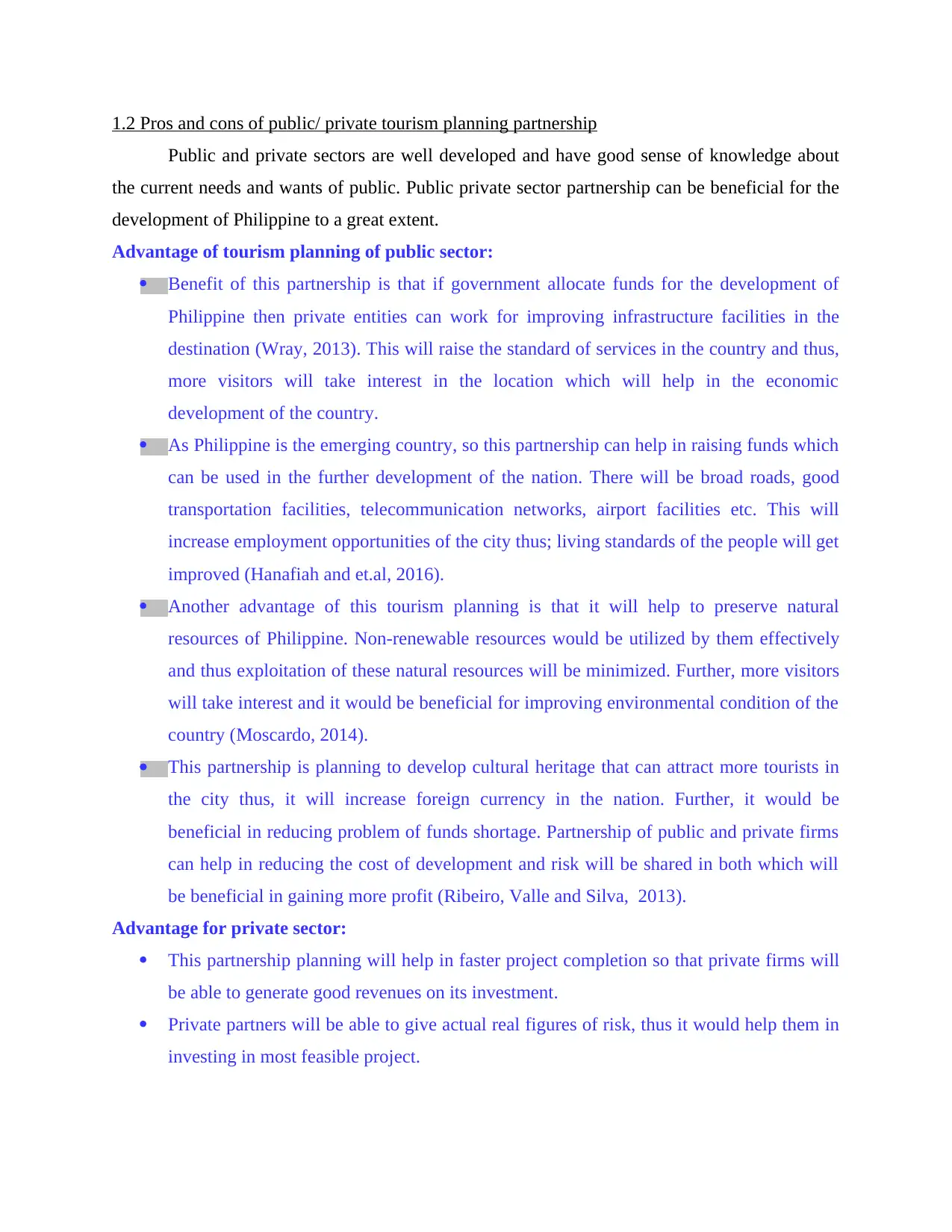
1.2 Pros and cons of public/ private tourism planning partnership
Public and private sectors are well developed and have good sense of knowledge about
the current needs and wants of public. Public private sector partnership can be beneficial for the
development of Philippine to a great extent.
Advantage of tourism planning of public sector:
Benefit of this partnership is that if government allocate funds for the development of
Philippine then private entities can work for improving infrastructure facilities in the
destination (Wray, 2013). This will raise the standard of services in the country and thus,
more visitors will take interest in the location which will help in the economic
development of the country.
As Philippine is the emerging country, so this partnership can help in raising funds which
can be used in the further development of the nation. There will be broad roads, good
transportation facilities, telecommunication networks, airport facilities etc. This will
increase employment opportunities of the city thus; living standards of the people will get
improved (Hanafiah and et.al, 2016).
Another advantage of this tourism planning is that it will help to preserve natural
resources of Philippine. Non-renewable resources would be utilized by them effectively
and thus exploitation of these natural resources will be minimized. Further, more visitors
will take interest and it would be beneficial for improving environmental condition of the
country (Moscardo, 2014).
This partnership is planning to develop cultural heritage that can attract more tourists in
the city thus, it will increase foreign currency in the nation. Further, it would be
beneficial in reducing problem of funds shortage. Partnership of public and private firms
can help in reducing the cost of development and risk will be shared in both which will
be beneficial in gaining more profit (Ribeiro, Valle and Silva, 2013).
Advantage for private sector:
This partnership planning will help in faster project completion so that private firms will
be able to generate good revenues on its investment.
Private partners will be able to give actual real figures of risk, thus it would help them in
investing in most feasible project.
Public and private sectors are well developed and have good sense of knowledge about
the current needs and wants of public. Public private sector partnership can be beneficial for the
development of Philippine to a great extent.
Advantage of tourism planning of public sector:
Benefit of this partnership is that if government allocate funds for the development of
Philippine then private entities can work for improving infrastructure facilities in the
destination (Wray, 2013). This will raise the standard of services in the country and thus,
more visitors will take interest in the location which will help in the economic
development of the country.
As Philippine is the emerging country, so this partnership can help in raising funds which
can be used in the further development of the nation. There will be broad roads, good
transportation facilities, telecommunication networks, airport facilities etc. This will
increase employment opportunities of the city thus; living standards of the people will get
improved (Hanafiah and et.al, 2016).
Another advantage of this tourism planning is that it will help to preserve natural
resources of Philippine. Non-renewable resources would be utilized by them effectively
and thus exploitation of these natural resources will be minimized. Further, more visitors
will take interest and it would be beneficial for improving environmental condition of the
country (Moscardo, 2014).
This partnership is planning to develop cultural heritage that can attract more tourists in
the city thus, it will increase foreign currency in the nation. Further, it would be
beneficial in reducing problem of funds shortage. Partnership of public and private firms
can help in reducing the cost of development and risk will be shared in both which will
be beneficial in gaining more profit (Ribeiro, Valle and Silva, 2013).
Advantage for private sector:
This partnership planning will help in faster project completion so that private firms will
be able to generate good revenues on its investment.
Private partners will be able to give actual real figures of risk, thus it would help them in
investing in most feasible project.
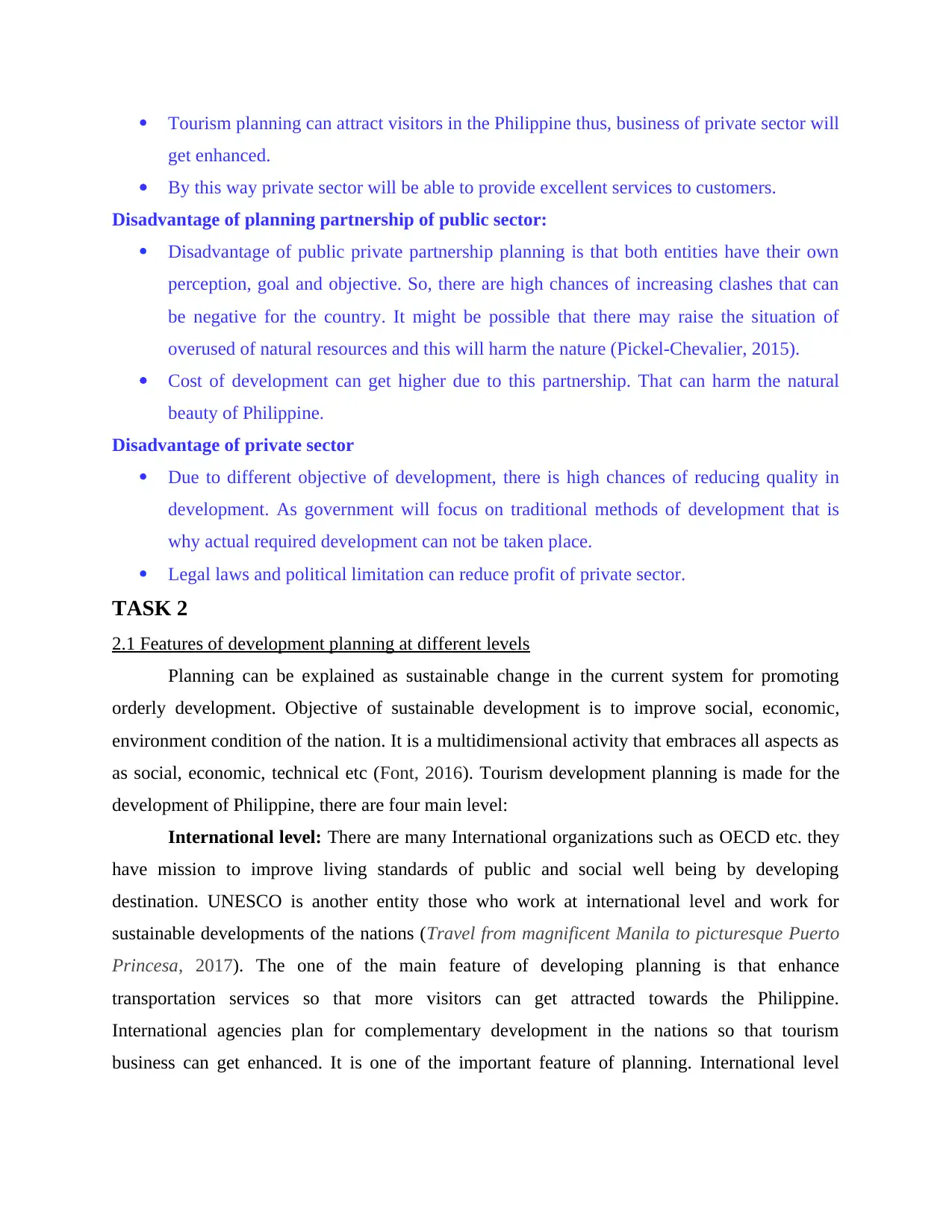
Tourism planning can attract visitors in the Philippine thus, business of private sector will
get enhanced.
By this way private sector will be able to provide excellent services to customers.
Disadvantage of planning partnership of public sector:
Disadvantage of public private partnership planning is that both entities have their own
perception, goal and objective. So, there are high chances of increasing clashes that can
be negative for the country. It might be possible that there may raise the situation of
overused of natural resources and this will harm the nature (Pickel-Chevalier, 2015).
Cost of development can get higher due to this partnership. That can harm the natural
beauty of Philippine.
Disadvantage of private sector
Due to different objective of development, there is high chances of reducing quality in
development. As government will focus on traditional methods of development that is
why actual required development can not be taken place.
Legal laws and political limitation can reduce profit of private sector.
TASK 2
2.1 Features of development planning at different levels
Planning can be explained as sustainable change in the current system for promoting
orderly development. Objective of sustainable development is to improve social, economic,
environment condition of the nation. It is a multidimensional activity that embraces all aspects as
as social, economic, technical etc (Font, 2016). Tourism development planning is made for the
development of Philippine, there are four main level:
International level: There are many International organizations such as OECD etc. they
have mission to improve living standards of public and social well being by developing
destination. UNESCO is another entity those who work at international level and work for
sustainable developments of the nations (Travel from magnificent Manila to picturesque Puerto
Princesa, 2017). The one of the main feature of developing planning is that enhance
transportation services so that more visitors can get attracted towards the Philippine.
International agencies plan for complementary development in the nations so that tourism
business can get enhanced. It is one of the important feature of planning. International level
get enhanced.
By this way private sector will be able to provide excellent services to customers.
Disadvantage of planning partnership of public sector:
Disadvantage of public private partnership planning is that both entities have their own
perception, goal and objective. So, there are high chances of increasing clashes that can
be negative for the country. It might be possible that there may raise the situation of
overused of natural resources and this will harm the nature (Pickel-Chevalier, 2015).
Cost of development can get higher due to this partnership. That can harm the natural
beauty of Philippine.
Disadvantage of private sector
Due to different objective of development, there is high chances of reducing quality in
development. As government will focus on traditional methods of development that is
why actual required development can not be taken place.
Legal laws and political limitation can reduce profit of private sector.
TASK 2
2.1 Features of development planning at different levels
Planning can be explained as sustainable change in the current system for promoting
orderly development. Objective of sustainable development is to improve social, economic,
environment condition of the nation. It is a multidimensional activity that embraces all aspects as
as social, economic, technical etc (Font, 2016). Tourism development planning is made for the
development of Philippine, there are four main level:
International level: There are many International organizations such as OECD etc. they
have mission to improve living standards of public and social well being by developing
destination. UNESCO is another entity those who work at international level and work for
sustainable developments of the nations (Travel from magnificent Manila to picturesque Puerto
Princesa, 2017). The one of the main feature of developing planning is that enhance
transportation services so that more visitors can get attracted towards the Philippine.
International agencies plan for complementary development in the nations so that tourism
business can get enhanced. It is one of the important feature of planning. International level
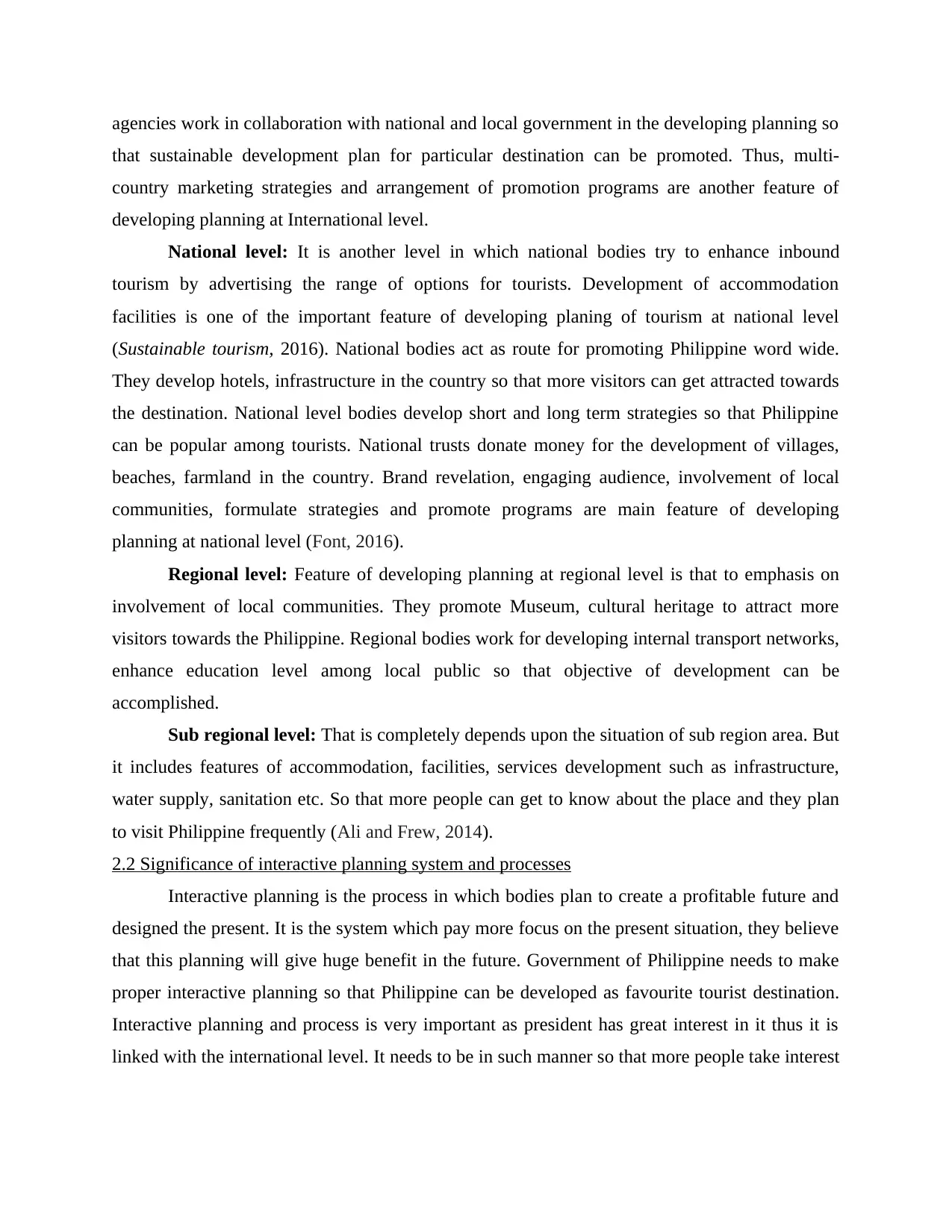
agencies work in collaboration with national and local government in the developing planning so
that sustainable development plan for particular destination can be promoted. Thus, multi-
country marketing strategies and arrangement of promotion programs are another feature of
developing planning at International level.
National level: It is another level in which national bodies try to enhance inbound
tourism by advertising the range of options for tourists. Development of accommodation
facilities is one of the important feature of developing planing of tourism at national level
(Sustainable tourism, 2016). National bodies act as route for promoting Philippine word wide.
They develop hotels, infrastructure in the country so that more visitors can get attracted towards
the destination. National level bodies develop short and long term strategies so that Philippine
can be popular among tourists. National trusts donate money for the development of villages,
beaches, farmland in the country. Brand revelation, engaging audience, involvement of local
communities, formulate strategies and promote programs are main feature of developing
planning at national level (Font, 2016).
Regional level: Feature of developing planning at regional level is that to emphasis on
involvement of local communities. They promote Museum, cultural heritage to attract more
visitors towards the Philippine. Regional bodies work for developing internal transport networks,
enhance education level among local public so that objective of development can be
accomplished.
Sub regional level: That is completely depends upon the situation of sub region area. But
it includes features of accommodation, facilities, services development such as infrastructure,
water supply, sanitation etc. So that more people can get to know about the place and they plan
to visit Philippine frequently (Ali and Frew, 2014).
2.2 Significance of interactive planning system and processes
Interactive planning is the process in which bodies plan to create a profitable future and
designed the present. It is the system which pay more focus on the present situation, they believe
that this planning will give huge benefit in the future. Government of Philippine needs to make
proper interactive planning so that Philippine can be developed as favourite tourist destination.
Interactive planning and process is very important as president has great interest in it thus it is
linked with the international level. It needs to be in such manner so that more people take interest
that sustainable development plan for particular destination can be promoted. Thus, multi-
country marketing strategies and arrangement of promotion programs are another feature of
developing planning at International level.
National level: It is another level in which national bodies try to enhance inbound
tourism by advertising the range of options for tourists. Development of accommodation
facilities is one of the important feature of developing planing of tourism at national level
(Sustainable tourism, 2016). National bodies act as route for promoting Philippine word wide.
They develop hotels, infrastructure in the country so that more visitors can get attracted towards
the destination. National level bodies develop short and long term strategies so that Philippine
can be popular among tourists. National trusts donate money for the development of villages,
beaches, farmland in the country. Brand revelation, engaging audience, involvement of local
communities, formulate strategies and promote programs are main feature of developing
planning at national level (Font, 2016).
Regional level: Feature of developing planning at regional level is that to emphasis on
involvement of local communities. They promote Museum, cultural heritage to attract more
visitors towards the Philippine. Regional bodies work for developing internal transport networks,
enhance education level among local public so that objective of development can be
accomplished.
Sub regional level: That is completely depends upon the situation of sub region area. But
it includes features of accommodation, facilities, services development such as infrastructure,
water supply, sanitation etc. So that more people can get to know about the place and they plan
to visit Philippine frequently (Ali and Frew, 2014).
2.2 Significance of interactive planning system and processes
Interactive planning is the process in which bodies plan to create a profitable future and
designed the present. It is the system which pay more focus on the present situation, they believe
that this planning will give huge benefit in the future. Government of Philippine needs to make
proper interactive planning so that Philippine can be developed as favourite tourist destination.
Interactive planning and process is very important as president has great interest in it thus it is
linked with the international level. It needs to be in such manner so that more people take interest
Secure Best Marks with AI Grader
Need help grading? Try our AI Grader for instant feedback on your assignments.
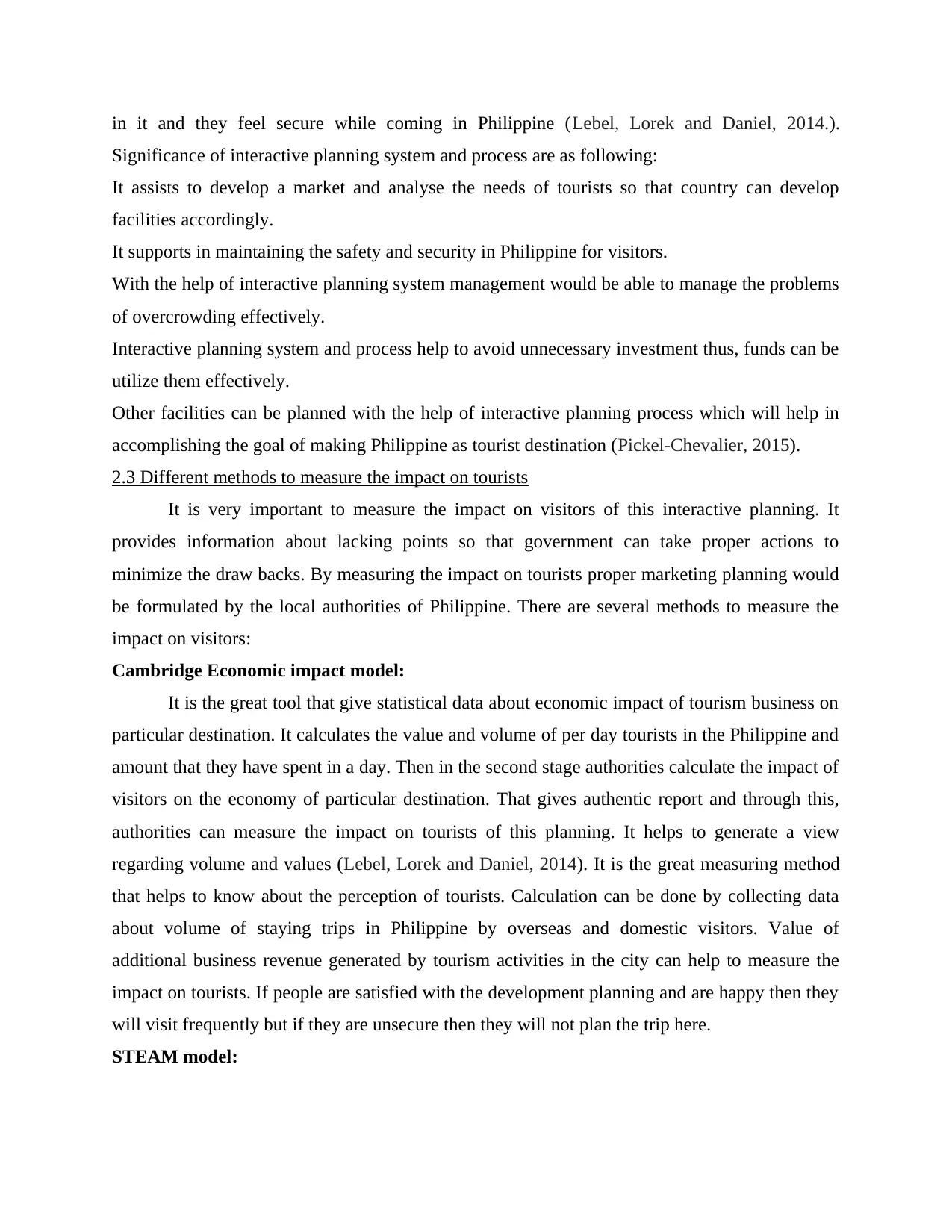
in it and they feel secure while coming in Philippine (Lebel, Lorek and Daniel, 2014.).
Significance of interactive planning system and process are as following:
It assists to develop a market and analyse the needs of tourists so that country can develop
facilities accordingly.
It supports in maintaining the safety and security in Philippine for visitors.
With the help of interactive planning system management would be able to manage the problems
of overcrowding effectively.
Interactive planning system and process help to avoid unnecessary investment thus, funds can be
utilize them effectively.
Other facilities can be planned with the help of interactive planning process which will help in
accomplishing the goal of making Philippine as tourist destination (Pickel-Chevalier, 2015).
2.3 Different methods to measure the impact on tourists
It is very important to measure the impact on visitors of this interactive planning. It
provides information about lacking points so that government can take proper actions to
minimize the draw backs. By measuring the impact on tourists proper marketing planning would
be formulated by the local authorities of Philippine. There are several methods to measure the
impact on visitors:
Cambridge Economic impact model:
It is the great tool that give statistical data about economic impact of tourism business on
particular destination. It calculates the value and volume of per day tourists in the Philippine and
amount that they have spent in a day. Then in the second stage authorities calculate the impact of
visitors on the economy of particular destination. That gives authentic report and through this,
authorities can measure the impact on tourists of this planning. It helps to generate a view
regarding volume and values (Lebel, Lorek and Daniel, 2014). It is the great measuring method
that helps to know about the perception of tourists. Calculation can be done by collecting data
about volume of staying trips in Philippine by overseas and domestic visitors. Value of
additional business revenue generated by tourism activities in the city can help to measure the
impact on tourists. If people are satisfied with the development planning and are happy then they
will visit frequently but if they are unsecure then they will not plan the trip here.
STEAM model:
Significance of interactive planning system and process are as following:
It assists to develop a market and analyse the needs of tourists so that country can develop
facilities accordingly.
It supports in maintaining the safety and security in Philippine for visitors.
With the help of interactive planning system management would be able to manage the problems
of overcrowding effectively.
Interactive planning system and process help to avoid unnecessary investment thus, funds can be
utilize them effectively.
Other facilities can be planned with the help of interactive planning process which will help in
accomplishing the goal of making Philippine as tourist destination (Pickel-Chevalier, 2015).
2.3 Different methods to measure the impact on tourists
It is very important to measure the impact on visitors of this interactive planning. It
provides information about lacking points so that government can take proper actions to
minimize the draw backs. By measuring the impact on tourists proper marketing planning would
be formulated by the local authorities of Philippine. There are several methods to measure the
impact on visitors:
Cambridge Economic impact model:
It is the great tool that give statistical data about economic impact of tourism business on
particular destination. It calculates the value and volume of per day tourists in the Philippine and
amount that they have spent in a day. Then in the second stage authorities calculate the impact of
visitors on the economy of particular destination. That gives authentic report and through this,
authorities can measure the impact on tourists of this planning. It helps to generate a view
regarding volume and values (Lebel, Lorek and Daniel, 2014). It is the great measuring method
that helps to know about the perception of tourists. Calculation can be done by collecting data
about volume of staying trips in Philippine by overseas and domestic visitors. Value of
additional business revenue generated by tourism activities in the city can help to measure the
impact on tourists. If people are satisfied with the development planning and are happy then they
will visit frequently but if they are unsecure then they will not plan the trip here.
STEAM model:

It is another measuring method that helps to identify the impact on tourists of
development. This technique gives an indicative base of impact on economic by collecting the
data about people those who stay here etc (Sustainable tourism, 2016). Impact on visitors can be
measured by following ways:
By collecting data about occupation percentage each month in each type of
accommodation.
Involvement of audience in events.
Bed stock of accommodation businesses.
Revenues generated by visitors.
Total count of visitors those who entered into Philippine.
Employment opportunities generated by visitor spending.
These details assist to measure the impact on tourists, as if there are high revenues
generated by hotels and transportation business then it can be assumed that this has impacted
positive on visitors. Same as if number of coming visitors are high then it means that people are
satisfied and feeing happy here (Ali and Frew, 2014).
Carrying capacity model: It is another measuring method, that identify that people those who are
occupied without harming the environment and quality of services. It calculates the average
duration of stay of tourist, type of visitors that come here. This will help to measure the impact
on tourists on Philippine.
TASK 3
3.1Concept of sustainability in tourism development
In poster
3.2 Factors that may prevent/hinder sustainable tourism development
In poster
3.3 Different stages in planning for sustainability
There are various stages of planning which can help in the sustainable development of
tourism in Philippine:
Planning stages for sustainability
Selection of stakeholders: Resources analyses: Implementation and
development. This technique gives an indicative base of impact on economic by collecting the
data about people those who stay here etc (Sustainable tourism, 2016). Impact on visitors can be
measured by following ways:
By collecting data about occupation percentage each month in each type of
accommodation.
Involvement of audience in events.
Bed stock of accommodation businesses.
Revenues generated by visitors.
Total count of visitors those who entered into Philippine.
Employment opportunities generated by visitor spending.
These details assist to measure the impact on tourists, as if there are high revenues
generated by hotels and transportation business then it can be assumed that this has impacted
positive on visitors. Same as if number of coming visitors are high then it means that people are
satisfied and feeing happy here (Ali and Frew, 2014).
Carrying capacity model: It is another measuring method, that identify that people those who are
occupied without harming the environment and quality of services. It calculates the average
duration of stay of tourist, type of visitors that come here. This will help to measure the impact
on tourists on Philippine.
TASK 3
3.1Concept of sustainability in tourism development
In poster
3.2 Factors that may prevent/hinder sustainable tourism development
In poster
3.3 Different stages in planning for sustainability
There are various stages of planning which can help in the sustainable development of
tourism in Philippine:
Planning stages for sustainability
Selection of stakeholders: Resources analyses: Implementation and
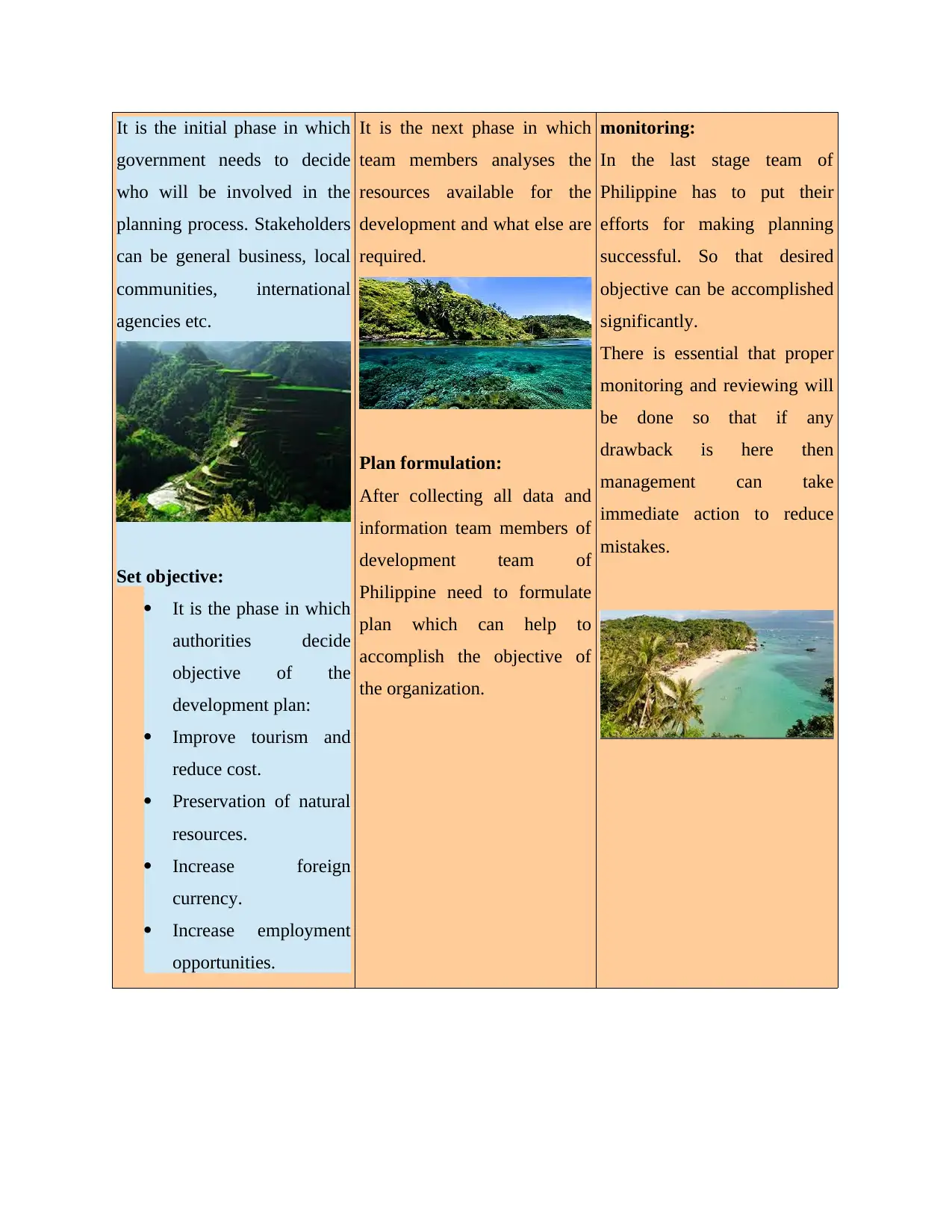
It is the initial phase in which
government needs to decide
who will be involved in the
planning process. Stakeholders
can be general business, local
communities, international
agencies etc.
Set objective:
It is the phase in which
authorities decide
objective of the
development plan:
Improve tourism and
reduce cost.
Preservation of natural
resources.
Increase foreign
currency.
Increase employment
opportunities.
It is the next phase in which
team members analyses the
resources available for the
development and what else are
required.
Plan formulation:
After collecting all data and
information team members of
development team of
Philippine need to formulate
plan which can help to
accomplish the objective of
the organization.
monitoring:
In the last stage team of
Philippine has to put their
efforts for making planning
successful. So that desired
objective can be accomplished
significantly.
There is essential that proper
monitoring and reviewing will
be done so that if any
drawback is here then
management can take
immediate action to reduce
mistakes.
government needs to decide
who will be involved in the
planning process. Stakeholders
can be general business, local
communities, international
agencies etc.
Set objective:
It is the phase in which
authorities decide
objective of the
development plan:
Improve tourism and
reduce cost.
Preservation of natural
resources.
Increase foreign
currency.
Increase employment
opportunities.
It is the next phase in which
team members analyses the
resources available for the
development and what else are
required.
Plan formulation:
After collecting all data and
information team members of
development team of
Philippine need to formulate
plan which can help to
accomplish the objective of
the organization.
monitoring:
In the last stage team of
Philippine has to put their
efforts for making planning
successful. So that desired
objective can be accomplished
significantly.
There is essential that proper
monitoring and reviewing will
be done so that if any
drawback is here then
management can take
immediate action to reduce
mistakes.
Paraphrase This Document
Need a fresh take? Get an instant paraphrase of this document with our AI Paraphraser
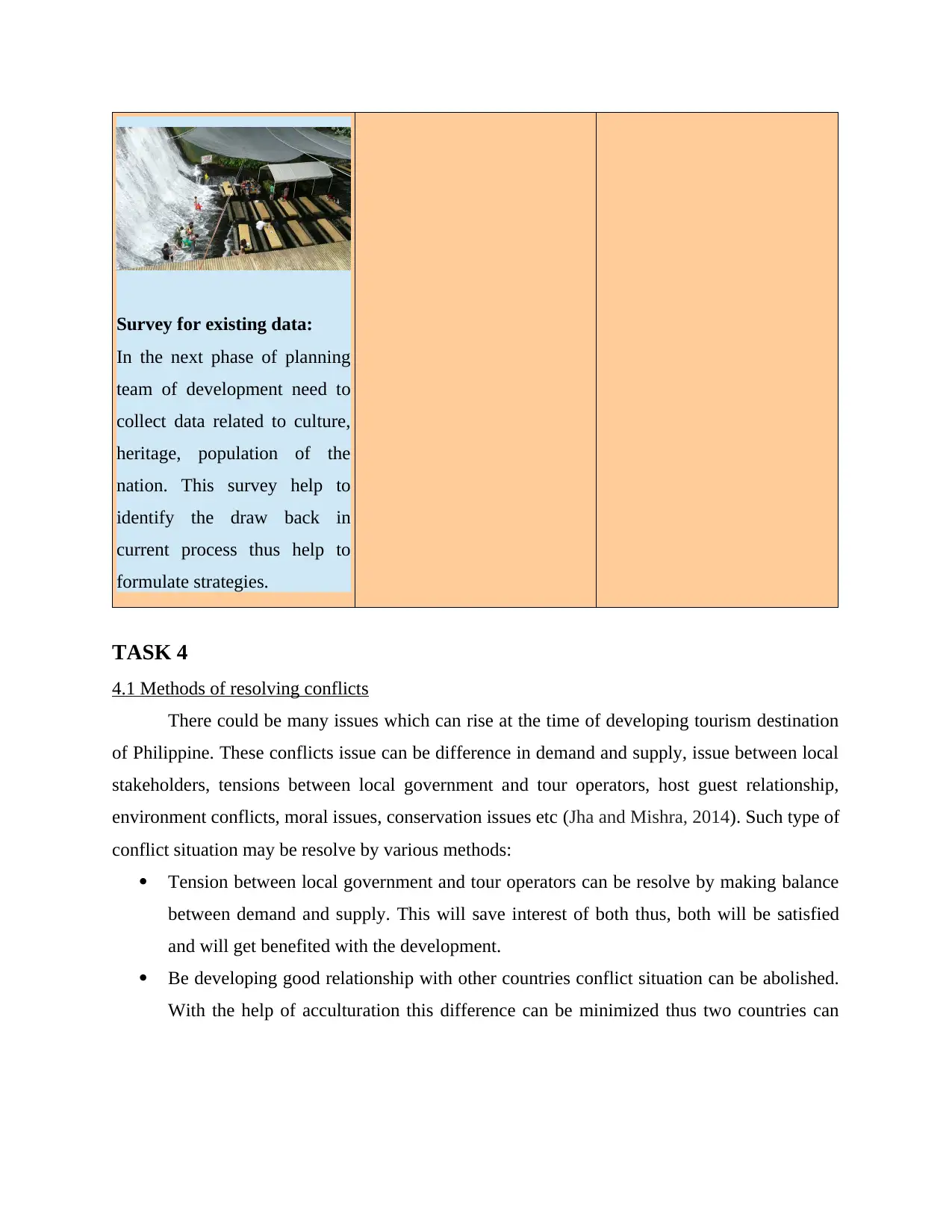
Survey for existing data:
In the next phase of planning
team of development need to
collect data related to culture,
heritage, population of the
nation. This survey help to
identify the draw back in
current process thus help to
formulate strategies.
TASK 4
4.1 Methods of resolving conflicts
There could be many issues which can rise at the time of developing tourism destination
of Philippine. These conflicts issue can be difference in demand and supply, issue between local
stakeholders, tensions between local government and tour operators, host guest relationship,
environment conflicts, moral issues, conservation issues etc (Jha and Mishra, 2014). Such type of
conflict situation may be resolve by various methods:
Tension between local government and tour operators can be resolve by making balance
between demand and supply. This will save interest of both thus, both will be satisfied
and will get benefited with the development.
Be developing good relationship with other countries conflict situation can be abolished.
With the help of acculturation this difference can be minimized thus two countries can
In the next phase of planning
team of development need to
collect data related to culture,
heritage, population of the
nation. This survey help to
identify the draw back in
current process thus help to
formulate strategies.
TASK 4
4.1 Methods of resolving conflicts
There could be many issues which can rise at the time of developing tourism destination
of Philippine. These conflicts issue can be difference in demand and supply, issue between local
stakeholders, tensions between local government and tour operators, host guest relationship,
environment conflicts, moral issues, conservation issues etc (Jha and Mishra, 2014). Such type of
conflict situation may be resolve by various methods:
Tension between local government and tour operators can be resolve by making balance
between demand and supply. This will save interest of both thus, both will be satisfied
and will get benefited with the development.
Be developing good relationship with other countries conflict situation can be abolished.
With the help of acculturation this difference can be minimized thus two countries can

develop good relationship with each other (Travel from magnificent Manila to
picturesque Puerto Princesa, 2017).
By making people aware with other cultures conflict of cultural issues can be reduced.
If there is high misuse of natural resources then it may create conflict situation between
government and tour operators, by making good planning and involvement of all
stakeholders can help to reduce such type of issues in Philippine.
4.2 Implication of balancing supply and demand
Balance between demand and supply is very important. In the economic term demand can
be explained needs of customers with particular product. In other words it shows the ability of
consumer of consumption of goods. If prices increased then quantity demand may get reduced.
Whereas supply can be defined as total availability of specific price products in the organization.
At particular time duration. Supply and prices are interrelated parts, if company increases prices
then revenues will get enhanced. On other hand it can reduce demand of the products. By making
equilibrium between both issues can be minimized and it will help in the sustainable
development of Philippine to great extent. Implication of balancing are as following:
If there is imbalance then it will create pressure on finite resources thus natural resources
will be reduced this will impact negative on the environmental conditions. Equilibrium
between both can help to preserve natural resources thus it will help to encourage people
to come to the Philippine for visiting its attractive weather and attractive points
(Patterson, 2016).
Balance between demand and supply will be beneficial for the local communities as they
will be able to live their life easily. Implication on balancing will be positive on them.
Proper balancing would be better in developing infrastructure facilities in the Philippine.
By this misuse of natural resources will be minimized (Travel from magnificent Manila
to picturesque Puerto Princesa, 2017).
If demand decrease then it will increase cost of tourism in Philippine. If demand remain
same but supply decreases then it will create situation of higher equilibrium prices.
Proper balancing will increase employment opportunities ion the nation to great extent.
picturesque Puerto Princesa, 2017).
By making people aware with other cultures conflict of cultural issues can be reduced.
If there is high misuse of natural resources then it may create conflict situation between
government and tour operators, by making good planning and involvement of all
stakeholders can help to reduce such type of issues in Philippine.
4.2 Implication of balancing supply and demand
Balance between demand and supply is very important. In the economic term demand can
be explained needs of customers with particular product. In other words it shows the ability of
consumer of consumption of goods. If prices increased then quantity demand may get reduced.
Whereas supply can be defined as total availability of specific price products in the organization.
At particular time duration. Supply and prices are interrelated parts, if company increases prices
then revenues will get enhanced. On other hand it can reduce demand of the products. By making
equilibrium between both issues can be minimized and it will help in the sustainable
development of Philippine to great extent. Implication of balancing are as following:
If there is imbalance then it will create pressure on finite resources thus natural resources
will be reduced this will impact negative on the environmental conditions. Equilibrium
between both can help to preserve natural resources thus it will help to encourage people
to come to the Philippine for visiting its attractive weather and attractive points
(Patterson, 2016).
Balance between demand and supply will be beneficial for the local communities as they
will be able to live their life easily. Implication on balancing will be positive on them.
Proper balancing would be better in developing infrastructure facilities in the Philippine.
By this misuse of natural resources will be minimized (Travel from magnificent Manila
to picturesque Puerto Princesa, 2017).
If demand decrease then it will increase cost of tourism in Philippine. If demand remain
same but supply decreases then it will create situation of higher equilibrium prices.
Proper balancing will increase employment opportunities ion the nation to great extent.

4.3 Moral and ethical issues of enclave tourism
Definition of Enclave tourism: Enclave tourism is the destination where tourist can come and can
enjoy the facilities. These destinations are within the host countries in remote areas. It helps to
develop relationship between two countries, visitors get excellent services in such places.
Tourism business now have become the leading business which contributes well in the economic
development of the country. There are many morale and ethical issues are involved in the
enclave tourism.
Issues elated to society, culture and economy are very common in this. As enclave
tourism focuses more on foreign tourists so there is high chances of emerging issues of
cultural differences. Lifestyle of Philippine people and foreign clients are differed so it
may create issue in the development of tourism.
Increased violence is another ethical issue which is associated with increased enclave
tourism in Philippine (Patterson, 2016).
It creates problem to climate and environmental conditions to great extent.
As enclave tourism is highly depended upon the foreign investment as goods get
imported that decreases the business of local persons. Inclusive hotels generate high
revenues by tourism business but its impact on the economy of Philippine will be very
low.
Local public do not get much opportunity in the enclave tourism (Travel from
magnificent Manila to picturesque Puerto Princesa, 2017).
TASK 5
5.1 Comparison of current issues associated with development of tourism
For the comparison Nepal has been selected as country and destination has been chosen
Croatia. Croatia is the part of Europe, it is developed country, whereas Nepal belongs to India
which is emerged country. Croatia has good relationship with some developed countries, its
export and imports are good that is why foreign reserves are sufficient in the country. But Nepal
is under developed, due to lack of resources still growth opportunities are less in the place. There
are many issues are associated with the tourism development:
Issue Croatia Nepal
Definition of Enclave tourism: Enclave tourism is the destination where tourist can come and can
enjoy the facilities. These destinations are within the host countries in remote areas. It helps to
develop relationship between two countries, visitors get excellent services in such places.
Tourism business now have become the leading business which contributes well in the economic
development of the country. There are many morale and ethical issues are involved in the
enclave tourism.
Issues elated to society, culture and economy are very common in this. As enclave
tourism focuses more on foreign tourists so there is high chances of emerging issues of
cultural differences. Lifestyle of Philippine people and foreign clients are differed so it
may create issue in the development of tourism.
Increased violence is another ethical issue which is associated with increased enclave
tourism in Philippine (Patterson, 2016).
It creates problem to climate and environmental conditions to great extent.
As enclave tourism is highly depended upon the foreign investment as goods get
imported that decreases the business of local persons. Inclusive hotels generate high
revenues by tourism business but its impact on the economy of Philippine will be very
low.
Local public do not get much opportunity in the enclave tourism (Travel from
magnificent Manila to picturesque Puerto Princesa, 2017).
TASK 5
5.1 Comparison of current issues associated with development of tourism
For the comparison Nepal has been selected as country and destination has been chosen
Croatia. Croatia is the part of Europe, it is developed country, whereas Nepal belongs to India
which is emerged country. Croatia has good relationship with some developed countries, its
export and imports are good that is why foreign reserves are sufficient in the country. But Nepal
is under developed, due to lack of resources still growth opportunities are less in the place. There
are many issues are associated with the tourism development:
Issue Croatia Nepal
Secure Best Marks with AI Grader
Need help grading? Try our AI Grader for instant feedback on your assignments.

Environmental issues It is emerging destination,
government is planning to
develop this location thus,
there is availability of good
hotels and infrastructure
facilities. As there is limited
population thus there is no
issue of pollution.
There are many resorts and
hotels that attract more
customers but due to
increasing pollution because of
traffic that creates issue for the
tourists. There are narrow
roads and lack of
transportation services.
There is no specific
infrastructure facilities so
sometimes visitors find it
difficult and face issue.
Economic issue Here there is good job
opportunities for the local
public. Due to good
transportation facilities visitors
take interest to come in such
place. It has limited economic
development opportunities
(Patterson, 2016).
There is lack of employment
opportunities, people come
here to visit its weather thus,
foreign currency is average.
Socio- Cultural issues People coordinate well with
other cultural people, there is
preservation of heritage.
Crime rate is very high in
Nepal, people pay more focus
on their culture it creates
problem for tourist in making
communication with local
public.
government is planning to
develop this location thus,
there is availability of good
hotels and infrastructure
facilities. As there is limited
population thus there is no
issue of pollution.
There are many resorts and
hotels that attract more
customers but due to
increasing pollution because of
traffic that creates issue for the
tourists. There are narrow
roads and lack of
transportation services.
There is no specific
infrastructure facilities so
sometimes visitors find it
difficult and face issue.
Economic issue Here there is good job
opportunities for the local
public. Due to good
transportation facilities visitors
take interest to come in such
place. It has limited economic
development opportunities
(Patterson, 2016).
There is lack of employment
opportunities, people come
here to visit its weather thus,
foreign currency is average.
Socio- Cultural issues People coordinate well with
other cultural people, there is
preservation of heritage.
Crime rate is very high in
Nepal, people pay more focus
on their culture it creates
problem for tourist in making
communication with local
public.
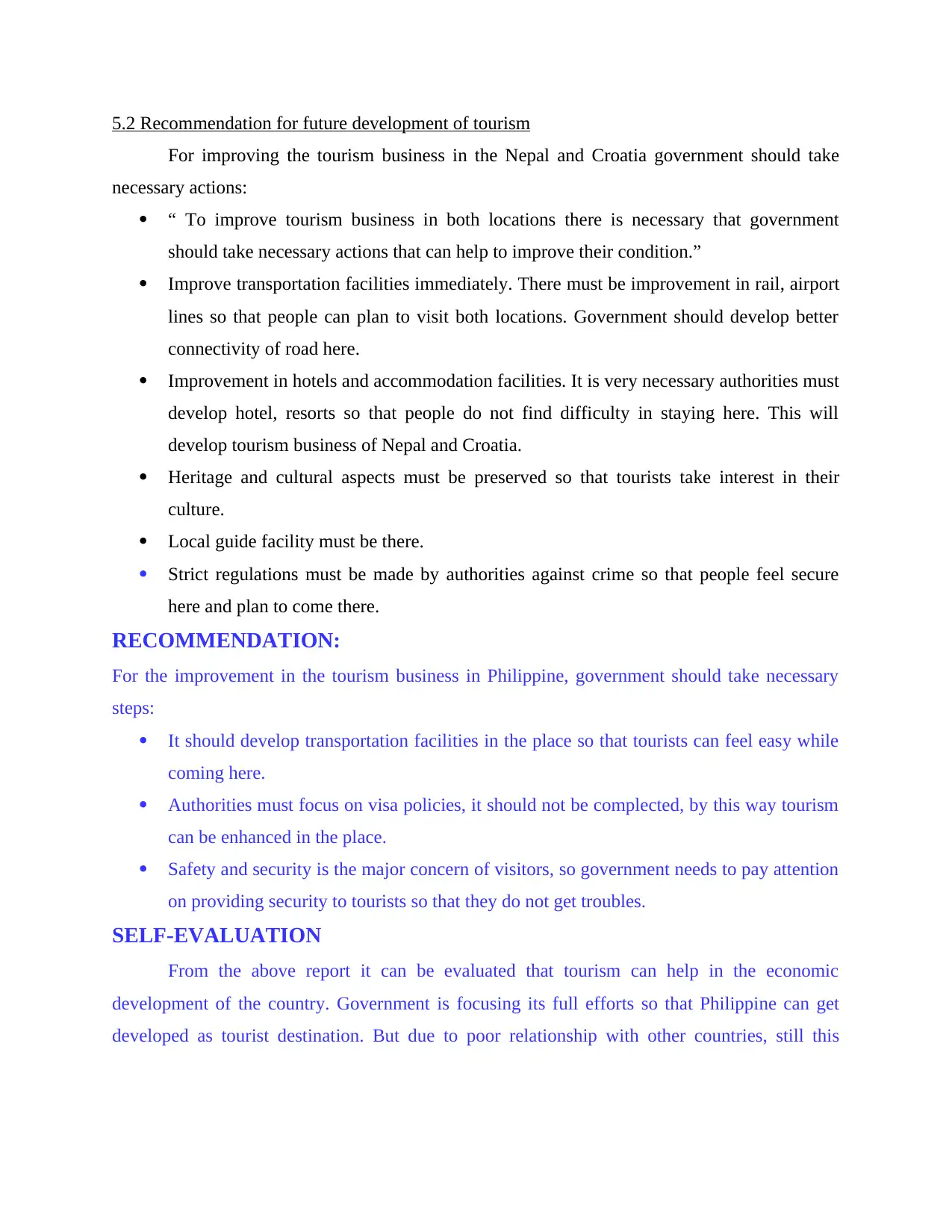
5.2 Recommendation for future development of tourism
For improving the tourism business in the Nepal and Croatia government should take
necessary actions:
“ To improve tourism business in both locations there is necessary that government
should take necessary actions that can help to improve their condition.”
Improve transportation facilities immediately. There must be improvement in rail, airport
lines so that people can plan to visit both locations. Government should develop better
connectivity of road here.
Improvement in hotels and accommodation facilities. It is very necessary authorities must
develop hotel, resorts so that people do not find difficulty in staying here. This will
develop tourism business of Nepal and Croatia.
Heritage and cultural aspects must be preserved so that tourists take interest in their
culture.
Local guide facility must be there.
Strict regulations must be made by authorities against crime so that people feel secure
here and plan to come there.
RECOMMENDATION:
For the improvement in the tourism business in Philippine, government should take necessary
steps:
It should develop transportation facilities in the place so that tourists can feel easy while
coming here.
Authorities must focus on visa policies, it should not be complected, by this way tourism
can be enhanced in the place.
Safety and security is the major concern of visitors, so government needs to pay attention
on providing security to tourists so that they do not get troubles.
SELF-EVALUATION
From the above report it can be evaluated that tourism can help in the economic
development of the country. Government is focusing its full efforts so that Philippine can get
developed as tourist destination. But due to poor relationship with other countries, still this
For improving the tourism business in the Nepal and Croatia government should take
necessary actions:
“ To improve tourism business in both locations there is necessary that government
should take necessary actions that can help to improve their condition.”
Improve transportation facilities immediately. There must be improvement in rail, airport
lines so that people can plan to visit both locations. Government should develop better
connectivity of road here.
Improvement in hotels and accommodation facilities. It is very necessary authorities must
develop hotel, resorts so that people do not find difficulty in staying here. This will
develop tourism business of Nepal and Croatia.
Heritage and cultural aspects must be preserved so that tourists take interest in their
culture.
Local guide facility must be there.
Strict regulations must be made by authorities against crime so that people feel secure
here and plan to come there.
RECOMMENDATION:
For the improvement in the tourism business in Philippine, government should take necessary
steps:
It should develop transportation facilities in the place so that tourists can feel easy while
coming here.
Authorities must focus on visa policies, it should not be complected, by this way tourism
can be enhanced in the place.
Safety and security is the major concern of visitors, so government needs to pay attention
on providing security to tourists so that they do not get troubles.
SELF-EVALUATION
From the above report it can be evaluated that tourism can help in the economic
development of the country. Government is focusing its full efforts so that Philippine can get
developed as tourist destination. But due to poor relationship with other countries, still this

planning is not being successful. Philippine is known for its natural beauty, authorities need to
focus on preserving the natural resources so that maximum tourists can get attracted towards the
destination.
CONCLUSION
From the above report it can be concluded that tourism business can support in the
economic development of the country. But there are many issues such as relationship with guest
country, cultural issue etc. that create problem in the sustainable development of tourism. Nepal
and Croatia both have capabilities to get developed as tourist destination, government needs to
focus on developing infrastructure facilities and making strict laws so that people can take interst
to visit such place.
REFERENCES
Books and Journals
Ali, A. and Frew, A. J., 2014. ICT for sustainable tourism: a challenging relationship?. J. of IT &
Tourism. 14(4). pp.261-264.
Chaperon, S. and Bramwell, B., 2013. Dependency and agency in peripheral tourism
development. Annals of tourism research. 40. pp.132-154.
Font, X., 2016. What meaning for sustainability? Creating tourism impacts in a slippery policy
context. Journal of Policy Research in Tourism, Leisure and Events. pp.1-7.
Hanafiah, M. H. and et.al., 2016. Responsible Tourism Practices and Quality of Life: Perspective
of Langkawi Island communities. Procedia-Social and Behavioral Sciences. 222. pp.406-
413.
Jha, A. K. and Mishra, J. M., 2014. Integrated and Participatory Approach to Sustainable
Tourism Development: A Conceptual Study. Journal of Tourism. 15.
Lebel, L., Lorek, S. and Daniel, R., 2014. Sustainable Production Consumption Systems (Vol. 9).
Springer.
focus on preserving the natural resources so that maximum tourists can get attracted towards the
destination.
CONCLUSION
From the above report it can be concluded that tourism business can support in the
economic development of the country. But there are many issues such as relationship with guest
country, cultural issue etc. that create problem in the sustainable development of tourism. Nepal
and Croatia both have capabilities to get developed as tourist destination, government needs to
focus on developing infrastructure facilities and making strict laws so that people can take interst
to visit such place.
REFERENCES
Books and Journals
Ali, A. and Frew, A. J., 2014. ICT for sustainable tourism: a challenging relationship?. J. of IT &
Tourism. 14(4). pp.261-264.
Chaperon, S. and Bramwell, B., 2013. Dependency and agency in peripheral tourism
development. Annals of tourism research. 40. pp.132-154.
Font, X., 2016. What meaning for sustainability? Creating tourism impacts in a slippery policy
context. Journal of Policy Research in Tourism, Leisure and Events. pp.1-7.
Hanafiah, M. H. and et.al., 2016. Responsible Tourism Practices and Quality of Life: Perspective
of Langkawi Island communities. Procedia-Social and Behavioral Sciences. 222. pp.406-
413.
Jha, A. K. and Mishra, J. M., 2014. Integrated and Participatory Approach to Sustainable
Tourism Development: A Conceptual Study. Journal of Tourism. 15.
Lebel, L., Lorek, S. and Daniel, R., 2014. Sustainable Production Consumption Systems (Vol. 9).
Springer.
Paraphrase This Document
Need a fresh take? Get an instant paraphrase of this document with our AI Paraphraser
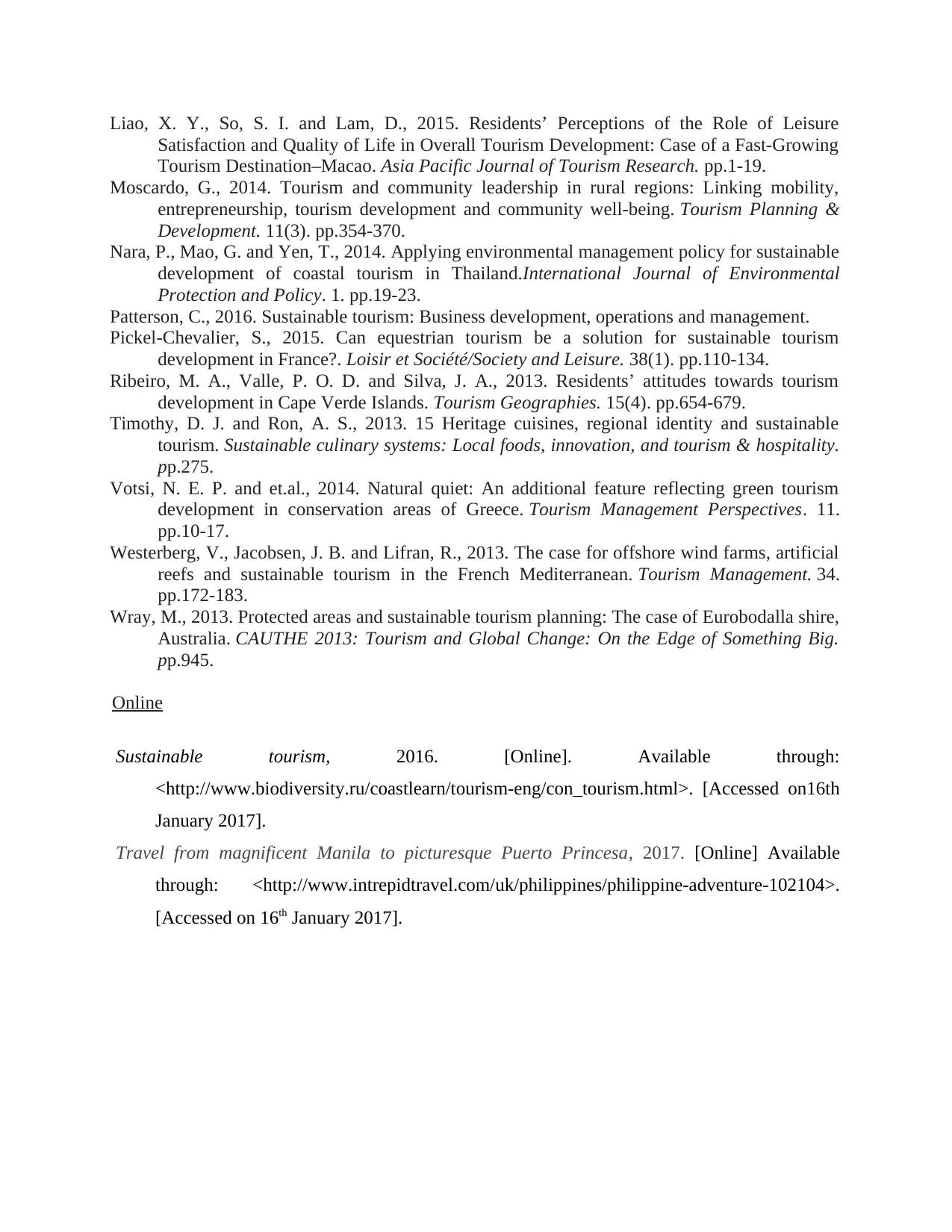
Liao, X. Y., So, S. I. and Lam, D., 2015. Residents’ Perceptions of the Role of Leisure
Satisfaction and Quality of Life in Overall Tourism Development: Case of a Fast-Growing
Tourism Destination–Macao. Asia Pacific Journal of Tourism Research. pp.1-19.
Moscardo, G., 2014. Tourism and community leadership in rural regions: Linking mobility,
entrepreneurship, tourism development and community well-being. Tourism Planning &
Development. 11(3). pp.354-370.
Nara, P., Mao, G. and Yen, T., 2014. Applying environmental management policy for sustainable
development of coastal tourism in Thailand.International Journal of Environmental
Protection and Policy. 1. pp.19-23.
Patterson, C., 2016. Sustainable tourism: Business development, operations and management.
Pickel-Chevalier, S., 2015. Can equestrian tourism be a solution for sustainable tourism
development in France?. Loisir et Société/Society and Leisure. 38(1). pp.110-134.
Ribeiro, M. A., Valle, P. O. D. and Silva, J. A., 2013. Residents’ attitudes towards tourism
development in Cape Verde Islands. Tourism Geographies. 15(4). pp.654-679.
Timothy, D. J. and Ron, A. S., 2013. 15 Heritage cuisines, regional identity and sustainable
tourism. Sustainable culinary systems: Local foods, innovation, and tourism & hospitality.
pp.275.
Votsi, N. E. P. and et.al., 2014. Natural quiet: An additional feature reflecting green tourism
development in conservation areas of Greece. Tourism Management Perspectives. 11.
pp.10-17.
Westerberg, V., Jacobsen, J. B. and Lifran, R., 2013. The case for offshore wind farms, artificial
reefs and sustainable tourism in the French Mediterranean. Tourism Management. 34.
pp.172-183.
Wray, M., 2013. Protected areas and sustainable tourism planning: The case of Eurobodalla shire,
Australia. CAUTHE 2013: Tourism and Global Change: On the Edge of Something Big.
pp.945.
Online
Sustainable tourism, 2016. [Online]. Available through:
<http://www.biodiversity.ru/coastlearn/tourism-eng/con_tourism.html>. [Accessed on16th
January 2017].
Travel from magnificent Manila to picturesque Puerto Princesa, 2017. [Online] Available
through: <http://www.intrepidtravel.com/uk/philippines/philippine-adventure-102104>.
[Accessed on 16th January 2017].
Satisfaction and Quality of Life in Overall Tourism Development: Case of a Fast-Growing
Tourism Destination–Macao. Asia Pacific Journal of Tourism Research. pp.1-19.
Moscardo, G., 2014. Tourism and community leadership in rural regions: Linking mobility,
entrepreneurship, tourism development and community well-being. Tourism Planning &
Development. 11(3). pp.354-370.
Nara, P., Mao, G. and Yen, T., 2014. Applying environmental management policy for sustainable
development of coastal tourism in Thailand.International Journal of Environmental
Protection and Policy. 1. pp.19-23.
Patterson, C., 2016. Sustainable tourism: Business development, operations and management.
Pickel-Chevalier, S., 2015. Can equestrian tourism be a solution for sustainable tourism
development in France?. Loisir et Société/Society and Leisure. 38(1). pp.110-134.
Ribeiro, M. A., Valle, P. O. D. and Silva, J. A., 2013. Residents’ attitudes towards tourism
development in Cape Verde Islands. Tourism Geographies. 15(4). pp.654-679.
Timothy, D. J. and Ron, A. S., 2013. 15 Heritage cuisines, regional identity and sustainable
tourism. Sustainable culinary systems: Local foods, innovation, and tourism & hospitality.
pp.275.
Votsi, N. E. P. and et.al., 2014. Natural quiet: An additional feature reflecting green tourism
development in conservation areas of Greece. Tourism Management Perspectives. 11.
pp.10-17.
Westerberg, V., Jacobsen, J. B. and Lifran, R., 2013. The case for offshore wind farms, artificial
reefs and sustainable tourism in the French Mediterranean. Tourism Management. 34.
pp.172-183.
Wray, M., 2013. Protected areas and sustainable tourism planning: The case of Eurobodalla shire,
Australia. CAUTHE 2013: Tourism and Global Change: On the Edge of Something Big.
pp.945.
Online
Sustainable tourism, 2016. [Online]. Available through:
<http://www.biodiversity.ru/coastlearn/tourism-eng/con_tourism.html>. [Accessed on16th
January 2017].
Travel from magnificent Manila to picturesque Puerto Princesa, 2017. [Online] Available
through: <http://www.intrepidtravel.com/uk/philippines/philippine-adventure-102104>.
[Accessed on 16th January 2017].
1 out of 17
Related Documents
Your All-in-One AI-Powered Toolkit for Academic Success.
+13062052269
info@desklib.com
Available 24*7 on WhatsApp / Email
![[object Object]](/_next/static/media/star-bottom.7253800d.svg)
Unlock your academic potential
© 2024 | Zucol Services PVT LTD | All rights reserved.





